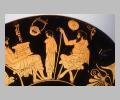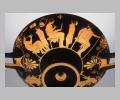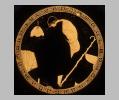| Collection: | Berlin, Antikenmuseen |
| Summary: | Interior: youth taking off his sandals |
| Ware: | Attic Red Figure |
| Painter: | Signed by Douris |
| Context: | From Caere |
| Date: | ca. 480 BC |
| Dimensions: | H. 11.5 m., d. 28.5 m. |
| Primary Citation: | |
| Shape: | Cup |
| Beazley Number: | 205092 |
| Region: | Etruria |
| Period: | Late Archaic/Early Classical |
Condition:
The vase is in good condition. There are some dark marks on the surface.
Decoration Description:
Interior: youth taking off his sandals. A naked youth bends to untie his sandal, his right foot propped on a stool. His left foot is still shod. The youth's knotty staff rests on the louterion behind him, and his mantle is draped over the stool. A sponge and aryballos hang above the stool.
Sides A and B: school. On each side are two pairs of teachers and students, and on the right a seated man who sits watching. Side A: The pair on the left practice the lyre. They sit on cushioned stools facing each other, the bearded teacher on the left, the student on the right. Both hold their lyres on their laps and are playing, their fingers spread across the strings. They wear their mantles pushed down around their waists to leave their upper bodies free. The teacher in the second pair sits on a cushioned chair facing right, his pupil standing before him with his mantle wrapped around him. The bearded teacher holds up a partly opened scroll on which something is written. His mantle is pushed down to free his arms and shoulders. A third bearded man sits on the right facing foward, his legs crossed at the ankles and his head turned to watch the school activities. He holds a staff in his right hand, and wears his mantle in the usual manner, covering one shoulder. Two lyres, two kylikes, a basket and a flute-case hang on the wall. There is an inscription along the upper edge of the scene.Side B: The two teachers on this side are young and beardless. The teacher on the left, seated on an uncushioned stool, plays a flute, his mantle pushed down to his waist. His young pupil stands facing him, wrapped in his mantle. The teacher in the center, who is seated on a cushioned stool facing right, holds a writing tablet on his lap, his stylus held in his raised right hand. His student also stands facing him, wrapped in his mantle. A bearded man sits on a cushioned stool on the right, facing right, but with his upper body and head turned toward the others. He holds a staff in one hand. A scroll, a writing tablet, a lyre, a cross-shaped object, and a sack hang on the wall. There is an inscription along the upper edge of the scene. All the figures on side A and side B wear red fillets.
Shape Description:
For the shape see Bloesch 98, Python no. 14.
Inscriptions:
Written in red in the interior on the left side of the tondo is the inscription: AJA 52 (1948) 338
Sources Used:
Other Bibliography:
The Greek world : classical, Byzantine, and modern (1985) 103





